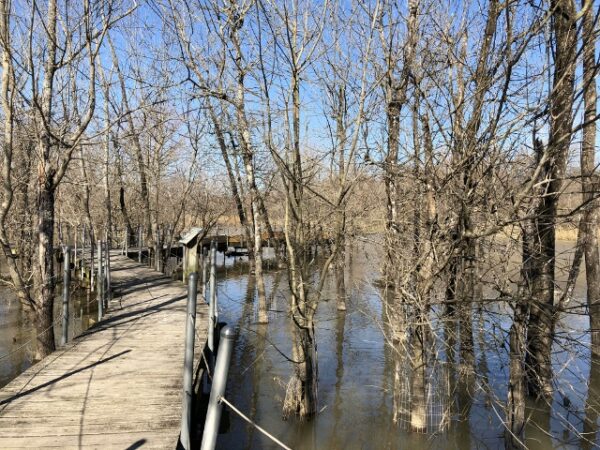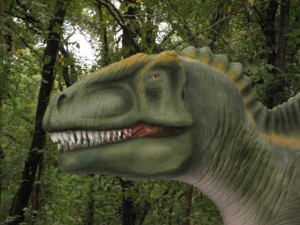
The Heard Natural History Museum and Wildlife Sanctuary in McKinney offers more than just a gorgeous natural setting for local hikes. During winter months, youngsters will delight in the exhibit of life-sized dinosaurs and naturalists of all ages will enjoy the year round museum exhibits. And did I mention the hiking trails through diverse habitats from forest to prairie to wetland?
Dinosaurs Live
A thunderous roar shatters the forest stillness. Beware. Beasts not seen for millions of years stalk the Heard Natural History Museum and Wildlife Sanctuary. Young paleontologists will find Brachiosaurus, Diabloceratops, Dilophosaurus, and the infamous Tyrannosaurus Rex roaming the trails at the sanctuary. View ten different dinosaurs along a loop trail through forest and meadow. These life-sized dinosaur replicas roar and move delighting young dinosaur enthusiasts.

Billings Production in Allen makes the animatronic creatures. The Heard dinosaurs are part of over 200 Billings’ dinosaurs found at zoos and museums throughout North American. The robotic dinosaurs are uniquely adapted to operate outdoors. A hinged steel structure within the fabricated body allows dinosaur heads and limbs to move. A computer program further enhances dinosaur movements making these monstrous creatures look and act almost real — Jurassic Park Texas style. The Heard’s fifteenth annual Dinosaurs Live continues through February 15.
Hike The Heard
While the dinosaurs draw the crowds, there is more to The Heard. Five hiking trails offer differing habitats to explore.
Bluestem and Wood Duck
We live in an ecoregion known as Blackland Prairie running from the Red River to San Antonio. Farming, ranching, and urbanization has decimated the original prairie land of tall grasses to just one percent of its original acreage. The Heard has restored several meadow-sized areas to prairie by careful cultivation of indigenousness grasses and plants. Bluestem trail gets its name from one of these clumping prairie grasses. The trail is one mile out and back, and easy walking.
Bluestem joins with Wood Duck to offer a completely different wetland habitat. The Wood Duck boardwalk takes you on a loop over shallow water and in among flooded trees. During summer months you’ll find turtles and snakes galore sunning themselves on fallen trees. We even found a few confused turtles out soaking up rays from a warmer than normal January sun. Across from the boardwalk, egrets often use the wetland for their rookeries. Combining Bluestem and Wood Duck trails, gives you a pleasant two-mile hike.
Hoot Owl
Located at the lower level of the museum, you’ll find the trailhead for Hoot Owl. The loop takes you through forest to the highest elevation at the sanctuary. At the overlook, you get a glimpse of Texas from before the dinosaurs when our region was covered by an ancient inland sea. The soil all around the overlook is white and part of the geological formation called Austin Chalk formed by long-dead sea creatures.
Hikers descend from the overlook into older forest of elm and oak. At the bottom of Hoot Owl, is the oldest tree on the sanctuary, a great Burr oak that has been core dated at over 230 years old. The Hoot Owl trail is a mile loop, but a more moderate hike due to changes in elevation.
Animals of the World
After your hike, check out the Animals of the World outdoor exhibit. The Heard houses a small number of native and exotic animals. Many exhibit animals imprinted with humans and cannot be released into the wild. Seized from an illegal animal breeder, some animals found new homes at the wildlife sanctuary. There are deer, bobcat, fox, and capybara, the world’s largest rodents. An albino raccoon found a home here too. My favorite are the bobcat brothers. These two were rescued by a farmer from a fire. The farmer brought the small kits to a rehabilitation center. The bobcat brothers recovered from their burns, but spent too much time with humans to be released back into the wild. The ‘boys’ are beautiful cats. During colder winter months, some of the exhibit animals, like the lemurs, are housed inside the museum.
When You Go
The Heard Natural History Museum and Wildlife Sanctuary is open Monday through Saturday from 9 a.m. until 5 p.m., and on Sunday from 1 until 5 p.m. Pets are not allowed in the sanctuary and there is an admission fee. The trails around Dinosaurs Live are accessible with a stroller, however all trails within the sanctuary are on natural, unpaved surfaces — challenging for wheel chairs and strollers. Picnic areas are available. Restrooms are inside the main building. The Heard Natural History Museum and Wildlife Sanctuary is at 1 Nature Place in McKinney.
Pandemic Impact
The Heard outdoor and indoor exhibits are open, however, masks are required throughout the sanctuary. Trails are narrow and there is enough crossing traffic, that masks are needed even when hiking. Because the dinosaurs draw so many families, you may want to consider a visit during the weekdays when trails are less crowded.
